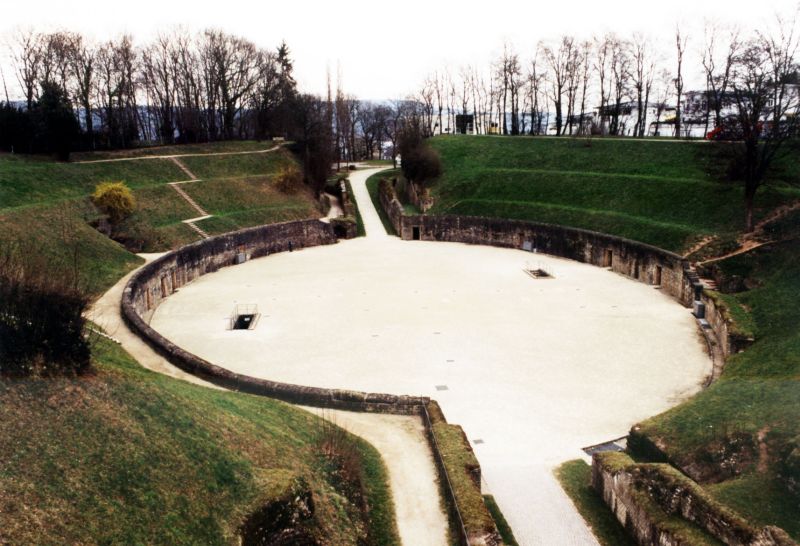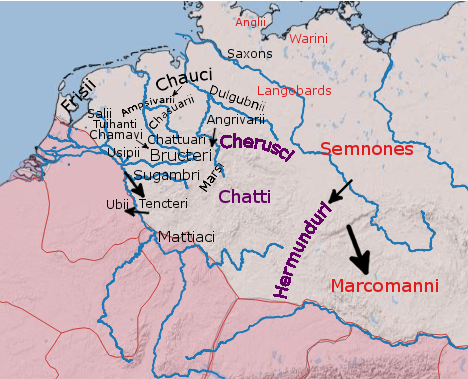|
Merogaisus
Merogais (, ) was an early Frankish king, who, along with his co-ruler Ascaric, is the earliest Frankish ruler known. He was an enemy of the Roman Empire. Merogais is mentioned in the ''Panegyrici latini'' (anonymous VI and VII) and by Eutropius and Eumenius. The very existence of Merogais depends on the manuscript reading of Johann Kaspar Zeuss. The sentence which names the two kings begins with ''Asacari'' or ''Assaccari'' in all manuscripts, but it ends with the corrupt forms ''cinere gaisique'', ''cumero geasique'', ''cymero craisique'', and ''cymero caisique''. Zeuss reads those sentences as ending respectively ''cum Neregaisique'', ''cum Merogeasique'', ''cum Merocraisique'', and ''cum Merocaisique'', each meaning as "and with Merogais". In 306 he and Ascaric led a Frankish raid across the Rhine into southern Gaul while Constantine the Great was campaigning against the Picts in Britannia. Apparently the two had made a previous agreement with Rome not to cross the border, s ... [...More Info...] [...Related Items...] OR: [Wikipedia] [Google] [Baidu] |
Bructeri
The Bructeri were a Germanic people, who lived in present-day North Rhine-Westphalia, just outside what was then the Roman Empire. The Romans originally reported them living east of the lower Rhine river, in a large area centred around present day Münster stretching from both sides of the upper River Ems in the north, to both sides of the River Lippe in the south. At its greatest extent, their territory apparently stretched between the vicinities of the Rhine in the west and the Teutoburg Forest and Weser river in the east. During the aggressive Roman campaigns of Augustus and his dynasty east of the Rhine into , the Bructeri were among the most dangerous enemies of Rome along with the Cherusci and Chatti. Compared to many neighbouring tribes they had a relatively large population and homeland, and could put significant armies into the field. Unlike many other tribes in their region they also continued to be an important power even during the centuries after the Romans consoli ... [...More Info...] [...Related Items...] OR: [Wikipedia] [Google] [Baidu] |
List Of Frankish Kings
The Franks, Germanic peoples that invaded the Western Roman Empire in the 5th century, were first led by individuals called dux, dukes and monarch, reguli. The earliest group of Franks that rose to prominence was the Salian Franks, Salian Merovingian dynasty, Merovingians, who conquered most of Roman Gaul, as well as the Gaulish territory of the Visigothic Kingdom, following the Battle of Vouillé in 507 AD. The sons of Clovis I, the first King of the Franks, conquered the Kingdom of the Burgundians, Burgundian and the Alamannia, Alamanni Kingdoms. They acquired Provence, and went on to make the peoples of the Bavarii and Thuringii their clients. The Merovingians were later replaced by the new Carolingian dynasty in the 8th century. By the late 10th century, the Carolingians themselves had been replaced throughout much of their realm by other dynasties. A timeline of Frankish rulers has been difficult to trace since the realm, according to old Germanic practice, was frequently ... [...More Info...] [...Related Items...] OR: [Wikipedia] [Google] [Baidu] |
Trier
Trier ( , ; ), formerly and traditionally known in English as Trèves ( , ) and Triers (see also Names of Trier in different languages, names in other languages), is a city on the banks of the Moselle (river), Moselle in Germany. It lies in a valley between low vine-covered hills of red sandstone in the west of the state of Rhineland-Palatinate, near the border with Luxembourg and within the important Mosel (wine region), Moselle wine region. Founded by the Ancient Romans, Romans in the late 1st century BC as ''Augusta Treverorum'' ("The City of Augustus among the Treveri"), Trier is considered Germany's oldest city. It is also the oldest cathedral, seat of a bishop north of the Alps. Trier was one of the four capitals of the Roman Empire during the Tetrarchy period in the late 3rd and early 4th centuries. In the Middle Ages, the archbishop-elector of Trier was an important prince of the Church who controlled land from the French border to the Rhine. The archbishop-elector of Tr ... [...More Info...] [...Related Items...] OR: [Wikipedia] [Google] [Baidu] |
4th-century Monarchs In Europe
The 4th century was the time period from 301 CE (represented by the Roman numerals CCCI) to 400 CE (CD) in accordance with the Julian calendar. In the West, the early part of the century was shaped by Constantine the Great, who became the first Roman emperor to adopt Christianity. Gaining sole reign of the empire, he is also noted for re-establishing a single imperial capital, choosing the site of ancient Byzantium in 330 (over the current capitals, which had effectively been changed by Diocletian's reforms to Milan in the West, and Nicomedeia in the East) to build the city soon called Nova Roma (New Rome); it was later renamed Constantinople in his honor. The last emperor to control both the eastern and western halves of the empire was Theodosius I. As the century progressed after his death, it became increasingly apparent that the empire had changed in many ways since the time of Augustus. The two-emperor system originally established by Diocletian in the previous century fel ... [...More Info...] [...Related Items...] OR: [Wikipedia] [Google] [Baidu] |
Frankish Warriors
Frankish may refer to: * Franks, a Germanic tribe and their culture ** Frankish language or its modern descendants, Franconian languages, a group of Low Germanic languages also commonly referred to as "Frankish" varieties * Francia, a post-Roman state in France and Germany * East Francia, the successor state to Francia in Germany * West Francia, the successor state to Francia in France * Crusaders * Levantines (Latin Christians) Family name * Ernest Frankish (1876–1962), New Zealand cricketer * Keith Frankish (born 1962), British philosopher * Kevin Frankish, Canadian television presenter and media personality * Pat Frankish, British psychologist and psychotherapist * Ronald Frankish (1925–2013), Australian cricketer * Stanley Frankish (1872–1909), New Zealand cricketer See also * Farang, Persian for 'Franks', later used for Western or Latin Europeans; in Arabic 'Faranj' * Franconian (other) * Franks (other) * Name of the Franks * Franks ... [...More Info...] [...Related Items...] OR: [Wikipedia] [Google] [Baidu] |
Frankish Kings
The Franks, Germanic peoples that invaded the Western Roman Empire in the 5th century, were first led by individuals called dux, dukes and monarch, reguli. The earliest group of Franks that rose to prominence was the Salian Franks, Salian Merovingian dynasty, Merovingians, who conquered most of Roman Gaul, as well as the Gaulish territory of the Visigothic Kingdom, following the Battle of Vouillé in 507 AD. The sons of Clovis I, the first King of the Franks, conquered the Kingdom of the Burgundians, Burgundian and the Alamannia, Alamanni Kingdoms. They acquired Provence, and went on to make the peoples of the Bavarii and Thuringii their clients. The Merovingians were later replaced by the new Carolingian dynasty in the 8th century. By the late 10th century, the Carolingians themselves had been replaced throughout much of their realm by other dynasties. A timeline of Frankish rulers has been difficult to trace since the realm, according to old Germanic practice, was frequently ... [...More Info...] [...Related Items...] OR: [Wikipedia] [Google] [Baidu] |
306 Deaths
__NOTOC__ Year 306 ( CCCVI) was a common year starting on Tuesday of the Julian calendar. At the time, it was known as the Year of the Consulship of Constantius and Valerius (or, less frequently, year 1059 ''Ab urbe condita''). The denomination 306 for this year has been used since the early medieval period, when the Anno Domini calendar era became the prevalent method in Europe for naming years. Events By place Roman Empire * July 25 – Constantius I dies outside Eboracum (modern-day York). Constantine, aged 23 or 24, is declared emperor by his troops. Emperor Galerius grants Constantine the title of Caesar, and elevates Flavius Valerius Severus to emperor in the Western part of the Roman Empire.''Consularia Constantinopolitana'' 306, in ''Monumenta Germaniae Historica'' ant. 11: '' Chronica Minora'' Vol. 1 (Theodor Mommsen ed., 1892) p. 231. * Constantine institutes toleration of the Christians in his territories. * Constantine establishes his capital in August ... [...More Info...] [...Related Items...] OR: [Wikipedia] [Google] [Baidu] |
In Eutropium
''In Eutropium'' is a two-book long panegyric poem and an invective written by the poet Claudian. The poem criticizes Eutropius, an Eastern Roman politician and court eunuch. It attempts to portray Eutropius as a corrupt, ineffective, and effeminate leader through a fictionalized telling of his life. The poem argues that he created a division between the Western and Eastern Roman Empires, and caused numerous problems for the Eastern Empire. Claudian uses this to highlight a contrast between his view of a corrupted and weak Eastern Empire and a powerful and righteous Western Empire. Plot The poem begins with Claudian recounting the career of Eutropius, an Eastern Roman politician and court eunuch, who became highly influential in the Imperial court. Claudian claims that Eutropius spent his early years as a catamite, a type of prepubescent male companion in a pederastic relationship in ancient Rome. According to Claudian, Eutropius went on to become a pimp and a lady's maid, be ... [...More Info...] [...Related Items...] OR: [Wikipedia] [Google] [Baidu] |
Amphitheatre
An amphitheatre (American English, U.S. English: amphitheater) is an open-air venue used for entertainment, performances, and sports. The term derives from the ancient Greek ('), from ('), meaning "on both sides" or "around" and ('), meaning "place for viewing". Ancient Greek Theater (structure), theatres were typically built on hillsides and semi-circular in design. The first amphitheatre may have been built at Pompeii around 70 BC. Ancient Roman amphitheatres were oval or circular in plan, with seating tiers that surrounded the central performance area, like a modern open-air stadium. In contrast, both ancient Greek and ancient Roman theatre (structure), Roman theatres were built in a semicircle, with tiered seating rising on one side of the performance area. Modern English parlance uses "amphitheatre" for any structure with sloping seating, including theater (structure), theatre-style stages with spectator seating on only one side, Theatre in the round, theatres in the ... [...More Info...] [...Related Items...] OR: [Wikipedia] [Google] [Baidu] |
Britannia
The image of Britannia () is the national personification of United Kingdom, Britain as a helmeted female warrior holding a trident and shield. An image first used by the Romans in classical antiquity, the Latin was the name variously applied to the British Isles, Great Britain, and the Roman province of Britain during the Roman Empire. The Roman Britannia was typically depicted reclining or seated, with not a trident but a spear and shield, appearing on Roman coins of the 2nd century AD. The classical allegory was revived in the early modern period. On coins of the pound sterling issued by Charles II of England, Scotland, and Ireland, Britannia appears with her shield bearing the Union Flag. To symbolise the Royal Navy's victories, Britannia's spear became the trident in 1797, and a helmet was added to the coinage in 1825. By the 1st century BC, Britannia had replaced Albion as the prevalent Latin name for the island of Great Britain. After the Roman conquest of Britain, Ro ... [...More Info...] [...Related Items...] OR: [Wikipedia] [Google] [Baidu] |







